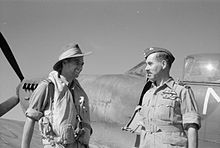|
No. 273 Squadron RAF
No. 273 Squadron RAF was a Royal Air Force squadron formed as reconnaissance unit in World War I, and re-formed in World War II in Ceylon (Sri Lanka) - initially as a torpedo bomber and reconnaissance unit. In mid 1944 the squadron was re-equipped with Spitfire Mk VIIIs and flew and fought out of airfields in India and Burma. Following the end of the war, the squadron was moved first to Siam (Thailand), and then later, French Indo-China (Vietnam). It was re-equipped with Spitfire Mk XIVs in November 1945. The squadron was disbanded at the end of January 1946. HistoryFormation and World War INo. 273 Squadron Royal Flying Corps was formed on 30 July 1918 and operated DH.4s, DH.9s and Sopwith Camels from Burgh Castle, Norfolk, on reconnaissance missions. It also operated from Covehithe airfield near the Suffolk coast, which was previously an RNAS night airfield.[1] The squadron disbanded on 5 July 1919 at Great Yarmouth. Reformation in World War II The squadron reformed on 1 August 1939 at China Bay in British Ceylon as a torpedo bomber squadron operating the Vickers Vildebeest. In March 1942, it equipped with the Fairey Fulmars (as the only RAF unit) and lost an aircraft during the Japanese attack on Ceylon on 9 April, shooting down several bombers in return.[2] It re-equipped with Hawker Hurricanes in August 1942[2] and then the Supermarine Spitfire Mk VIII in March 1944. From March 1944, pilots were given the new Spitfire Mk VIII to fly, and the squadron was moved up to British India to join in the war against Japanese imperial forces. From May 1944 through to the end of the war, it was recorded that 14 pilots were killed. From March to early July 1944, was the period in which the major Japanese attacks (Operation U-Go) against Imphal and Kohima were beaten back by Allied Indian and British forces, greatly assisted by the Third Tactical Air Force (TAF). The monsoon rains then followed, so that the next major round of strategic land battles commenced in late 1944 and early 1945. The Allied 14th Army pushed into Central Burma in January/February 1945, with their initial principal objectives being Meiktila and Mandalay. Mandalay fell towards the end March 1945, and the next imperative was to capture Rangoon before the monsoon rains started in earnest. Along the coast, 273 Squadron was part of No. 224 Group RAF (which in turn was part of the RAF Third Tactical Air Force). The RAF here was charged to support Commonwealth ground forces belonging to XV Corps, the role of which was to drive Japanese forces out of the coastal Arakan region. During July/August 1944, 273 Squadron flew out of Chittagong; and then mainly operated out of Cox’s Bazar from September–December 1944. During January 1945 the squadron operated out of the more inland Maunghnama. There was constant fighting over this period, this concentrating on ground support operations for the army, but also flying against Japanese Nakajima Ki-43 Oscars (based out of Akyab), and convoy patrols. At least one pilot was killed over this period. Akyab was evacuated by the Japanese at the end of December 1944, and Ramree Island was then occupied by Allied forces in February 1945. From February through to early May, 273 Squadron was based at Ramree Island, where it supported army operations as they moved against Japanese forces further south down the coast. Again this was a period of intense fighting, when at least a further three other pilots were killed. Rangoon was liberated by early May, and 273 Squadron moved into its new base at Mingaladon (just outside Rangoon) in the middle of that month. There was then a six-week period of somewhat frustrating operations, taken up mainly with patrolling. The first three weeks of July however involved a further final period of intense fighting however, as Allied army units and the RAF decimated Japanese forces as they attempted to cross the Sittang River, and head back towards Thailand. At least three other pilots were killed during these final operations. In mid-September, 273 Squadron was transferred to Don Muang, Siam (Thailand), and then moved to Tan Son Nhut, French Indo-China (Vietnam) at the end of that month. The squadron was re-equipped with Spitfire Mk XIVs in November 1945, used them in their only offensive operation on 11 December against Viet Minh in support of a surrounded French unit at Ban Me Thout and then finally disbanded (at Tan Son Nhut) at the end of January 1946. Badge designA squadron badge was submitted to the Air Ministry in November 1944. The design included an ancient Asian fylfot (which strongly resembles a swastika) and a black widow spider, together with the motto Toujours prêt. It was still awaiting final approval after several re-submissions when it had been rejected by Air Command South-East Asia and by the Inspector of RAF Badges. The squadron was disbanded before being issued a badge.[3] A campaign in 1996 to have the badge issued for the veterans of No. 273 Squadron was unsuccessful despite the backing of several MPs, and it was finally awarded to the squadron association in principle.[4] The badge is seen in the RAF Chapel at St Clement Danes, London. Aircraft operated
A Tachikawa Ki-54 was briefly pressed into service by the squadron in September and October 1945, due to a lack of suitable fuel for the unit's Spitfires.[6] References
External linksWikimedia Commons has media related to No. 273 Squadron RAF.
|
||||||||||||||||||||||||||||||||||||||||||||||||||||||||||||